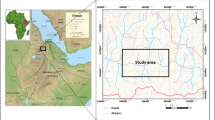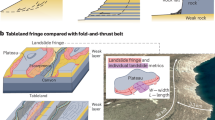Abstract
Large rock and soil landslides are an important part of the geodiversity in Nahanni National Park in Canada’s Northwest Territories. Here we describe five notable events, including two in soil, two in rock, and one involving rock and soil. Three of the events resulted in landslide dams. The Ram Plateau flowslide involved a collapse of a scree slope and fine textured soil over massive ground ice. This complex landslide continues to move in response to permafrost thaw and seasonal moisture. The Wrigley landslide is a large debris slide, involving thick till that dammed Wrigley Creek. The Cathedral Creek rock slide is a dip slope failure which dammed two large creeks. Cliff collapse of limestone on the Ram Plateau transformed into a rock avalanche, which dammed a stream. The Grizzly landslide involved both rock and soil. It is a large rock slide—earth flow in which, we suspect, undrained loading played an important role.
Access provided by Autonomous University of Puebla. Download conference paper PDF
Similar content being viewed by others
Keywords
1 Introduction
The South Nahanni watershed has a diverse terrain comprising rolling hills, rugged mountains, plateaus, and steep canyons. The region has been uplifted, folded and faulted, and is subject to earthquake activity. The dynamic environment of the South Nahanni watershed creates favourable conditions for slope failures.
In 2005 and 2006, we mapped landslides over 24,000 km2 of the watershed using aerial photography and ASTER satellite imagery, and conducted field investigations for validation.
Most large landslides occur in the eastern portion of the study area, generally in Paleozoic limestone and shale lithologies.
2 Landslides Observed Within Nahanni
We concentrated our field investigations on Tlogotsho and Ram plateaus, and Cathedral and Wrigley creeks (Fig. 59.1). Landslides in these regions occurred along steep canyon and cliff faces, on steep slopes within the mountains, and on lower terrain. Landslides also occurred on slopes underlain by permafrost. Within the areas visited, there were five notable landslides; a rock slide—earth flow, two rock slides, flowslide, and a debris slide—several of which were found to have impounded streams.
2.1 Complex Rock Slide: Earth Flow, Tlogotsho Plateau
We identified in the Tlogotsho Plateau, long-runout earth flows on low-gradients (typically less than 7°), mainly on north-facing slopes. The Grizzly landslide covers 7 km2 and traveled approximately 4 km (Fig. 59.2a–c). The upper portion of the slide displays both rotational and translational movement in jointed sandstone and siltstone along a shale rupture surface (Fig. 59.2d). The middle to lower portions of the landslide involved flowing and minor sliding of cohesive soil on a gradient of 3º. The landslide can thus be classified as a rock slide—earth flow. Based on aerial photos, satellite imagery, and field work observations, this slide was first active prior to 1949 and achieved its current form and extent over 10 years ago (Fig. 59.2a, b). The long runout of this and other similar slides may be caused by undrained loading of cohesive earth material generated by the rock slide. Similar landslides have been described by Geertsema (2006) in northern British Columbia.
Imagery of the rock slide-earth flow in the Tlogotsho Plateau (photos taken by Dr. Marten Geertsema and Courtney Jermyn). White dashed lines represent rock slide movement and white dotted lines signify earth flow movement. a ASTER ortho-image: shadows on north-facing slopes obscure exposed bedrock. b 1:40,000 scale, cropped 1949 air photo; A12295-182. c Oblique photo illustrating rock slide-earth flow features. d Jointed siltstone located at the base of a rotational rock slide (location identified by the circle in photo c)
2.2 Rock Slide, Ram Plateau
This rock slide is located on an unnamed river within a canyon incised in the Ram Plateau. The landslide was likely triggered by a rock fall from the steep, limestone cliff face (Fig. 59.3a). The failed rock rubble moved down slope, entrained lake sediments and ran 20–25 m up the opposite side of the valley (Fig. 59.3b, c). The lake is located on the south side of the landslide deposit and was originally 4 m higher than at present (Fig. 59.3c). We determined the previous highest level of the lake from the presence of a spillway marked by accumulation of woody debris and lateral margins formed in the rock debris. The rock slide was not visible on 1949 air photos indicating that the failure post dates 1949. In addition, the absence of vegetation and disturbance of the landslide deposits and fresh preservation of the spillway (Fig. 59.3d) suggest this failure was recent. Due to cloud cover over the failed region in the image, it was not possible to determine if this rock slide pre- or post-dated the imagery.
2.3 Active Complex Earth Slide–Earth Flow (Flowslide), Ram Plateau
We located an active complex landslide south of the rock slide in the canyon on the Ram Plateau (Fig. 59.4a–d). Based on field observations, it appears that riverbank erosion exposed fine-grained glacial lake sediments, causing an earth slide—earth flow that dammed the river (Fig. 59.4a, b, d). The flowslide exposed permafrost (ground ice) and angular rubble in a talus slope (Fig. 59.4c). The exposed permafrost thawed resulting in retrogressive flows. The ASTER scene did not provide additional information about the failure because of strong shadows. Field observations suggest the failure post-dates the ASTER scene acquired in 2000 because retrogressive thaw flow activity was ongoing during our visit.
2.4 Debris Slide, Wrigley Creek
During field investigations we identified a translational debris slide (Fig. 59.5a, c, d, and e). The displaced material is matrix-supported diamicton containing sub-rounded to angular clasts (Fig. 59.5d). A landslide-dammed lake was located on the north side of the deposit, and based on strandlines on the shore, the lake was 10 m deeper than at the time of our field visit (Fig. 59.5e).
Wrigley Creek debris slide: a ASTER scene (white dashed line identifies the debris slide); b 1949 air photo A12319-230: 1:40,000 scale. The image pre-dates the landslide. The air photo has a higher resolution than the ASTER scene. Geomorphological detail is comparable in the two aerial images. Because the air photo pre-dates the landslide event, gully formation in the headscarp region is visible. The presence of gullies suggest that the material is glacial in origin (white dashed line identifies the debris slide); c molards; d failed diamicton; and e view of the landslide-dammed lake. Photos taken by Dr. Marten Geertsema and Courtney Jermyn
The slide dates post 1949 as it was not present in the 1949 air photos but was identified in ASTER scenes scanned in the early 2000s. In the field we identified large conical mounds of debris (molards), up to 12 m in height, across the entire deposition zone (Fig. 59.5c). The molards gave the landslide a blocky texture in the ASTER scene.
2.5 Rock Slide, Cathedral Creek
A large rock slide occurred at the confluence of Cathedral and Clearwater creeks (Fig. 59.6a, b). The movement occurred along a dipping bedding plane. The landslide dammed the two creeks forming two lakes. The lake along Clearwater creek was approximately 5 km in length (Parks Canada 2012). Through correspondence with David Murray from Parks Canada in 2005 and reinstated by Parks Canada (2012), the failure occurred in the winter of 1996–1997, which followed a series of earthquake events in the region that year. In the summer of 1997, a portion of the natural dam, caused by the landslide, breached causing an outburst flood that dropped the lake along Clearwater creek 15 m; raising the level of the South Nahanni River in Deadman Valley by more than 4 m. Although no one was injured as a result of the flash flood, groups of canoeists camping downstream had to pack up quickly to avoid the event. The stability of the dam is unknown (Parks Canada 2012).
3 Discussion
The observations on large landslides described above, is part of a larger landslide inventory project in the South Nahanni watershed. Results show that many types of failures occur in the watershed. We learned from the landslide inventory and site investigations that in the Ram Plateau and the Ragged Ranges, debris flows and rock falls predominately originate along cliffs in karst gorges and on steep mountain slopes. Rock slide-debris flow failures, also common in these regions, initiate along bedding planes on steep valley walls. Huntley and Duk-Rodkin (2006) identified similar failure mechanisms in the neighbouring Mackenzie Valley. The Tlogotsho Plateau contains many complex rock slide-earth flows, like the Grizzly slide, but also earth flows. Complex slides occur where jointed sandstone and siltstone fail along incompetent shale. Earth flows initiate in shale lower on escarpments. Complex earth slides are found at low elevations within the watershed where glacial deposits are most abundant. They occur predominately along active tributaries and river systems. Morphology of some earth slides in the Ram Plateau area resembles features illustrated by Huntley et al. (2006), suggesting that these failures are active layer detachments or retrogressive-thaw flows caused by permafrost degradation. Landslide activity in the Ragged Ranges of the Mackenzie Mountains is characterized by debris flows and rock slides; the latter appear to slide on bedding planes in agreement with the conclusions of Eisbacher (1977, 1979) and Jackson (1987) who also found that bedrock landslides in this area are controlled by rock structure.
4 Conclusion
The landslide inventory identified the Tlogotsho and Ram plateaus, and the creek systems such as Cathedral and Wrigely creeks in the eastern part of the watershed, as especially prone to failure. Based on field studies and the interpretation of remotely sensed imagery, landslide activity in this area is explained by geology (rock type, rock structure, and surficial materials), river undercutting of slopes, and the presence of permafrost.
References
Eisbacher GH (1977) Rockslides in the Mackenzie mountains, District of Mackenzie. Geological Survey of Canada, Paper 77-1A, p. 235–241
Eisbacher GH (1979) Cliff collapse and rock avalanches (sturzstroms) in the Mackenzie mountains, northwestern Canada. Can Geotech J 16:309–334
Geertsema M (2006) Hydrogeomorphic hazards in northern British Columbia. Netherlands Geographical Studies 341, Utrecht, The Netherlands, 185 p
Huntley D, Duk-Rodkin A (2006) Landslide processes in the south-central Mackenzie River valley region, Northwest Territories, Geological Survey of Canada, Current Research, 2006-A9, 7 p
Huntley D, Duk-Rodkin A, Sidwell C (2006) Landslide inventory of the south-central Mackenzie river valley region, Northwest Territories. Geological Survey of Canada, Current Research 2006-A10, 11 p
Jackson LE Jr. (1987) Terrain inventory and Quaternary history of Nahanni map area, Yukon and Northwest Territories. Geological Survey of Canada, Paper 86-18, 23 p
Jermyn C (2011) An approach for remote landslide mapping, South Nahanni Watershed, Northwest Territories Canada. Master of Science thesis, University of Northern British Columbia, Prince George, BC, 135 p
Parks Canada (2012) River Hazards. http://www.pc.gc.ca/pn-np/nt/nahanni/visit/visit6/b.aspx. Accessed 27 Oct 2013
Author information
Authors and Affiliations
Corresponding authors
Editor information
Editors and Affiliations
Rights and permissions
Copyright information
© 2015 Springer International Publishing Switzerland
About this paper
Cite this paper
Jermyn, C., Geertsema, M. (2015). An Overview of Some Recent Large Landslide Types in Nahanni National Park, Northwest Territories, Canada. In: Lollino, G., Manconi, A., Clague, J., Shan, W., Chiarle, M. (eds) Engineering Geology for Society and Territory - Volume 1. Springer, Cham. https://doi.org/10.1007/978-3-319-09300-0_59
Download citation
DOI: https://doi.org/10.1007/978-3-319-09300-0_59
Published:
Publisher Name: Springer, Cham
Print ISBN: 978-3-319-09299-7
Online ISBN: 978-3-319-09300-0
eBook Packages: Earth and Environmental ScienceEarth and Environmental Science (R0)










